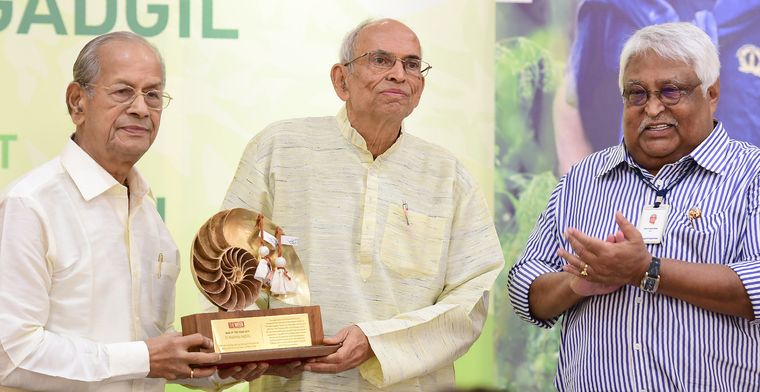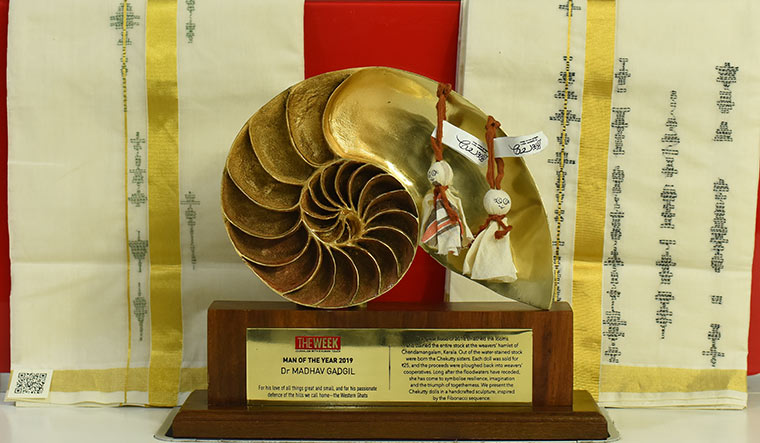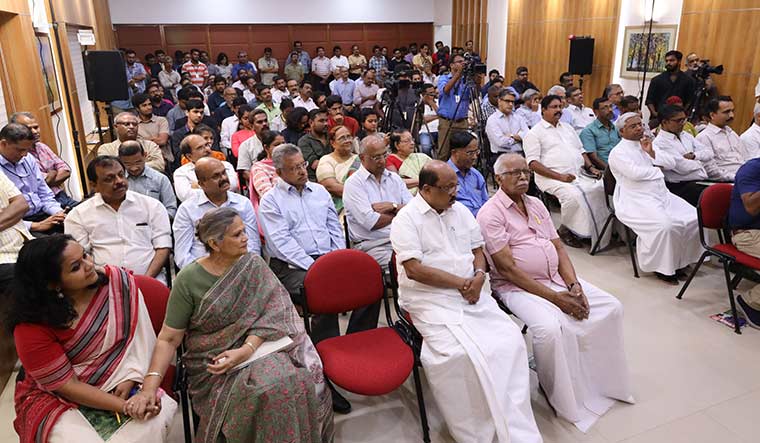There are not many things environmentalist Dr Madhav Gadgil, who calls himself a practising scientist, swears his allegiance to. Science, undoubtedly, is on the list; the other is India’s Constitution and the rights it guarantees. In this country whose Constitution starts off as ‘We, the people of India’, said Gadgil, people have to be at the core of whatever we do. He was addressing a select gathering after receiving THE WEEK’s Man of the Year 2019 award from Dr E. Sreedharan, principal adviser to Delhi Metro Rail Corporation, at a function in Kochi on February 4.
In recent times, Gadgil has become synonymous with the Western Ghats or the Sahyadri—the name he prefers over the anglicised version. With many of his predictions about natural disasters coming true, the 77-year-old environmentalist is seen as a prophet of the times. When the Western Ghats Ecology Expert Panel, headed by Gadgil, tabled its report in 2011, he stated: “The Western Ghats has been torn asunder by the greed of the elite and gnawed at by the poor, striving to eke out subsistence. This is a great tragedy, for this hill range is the backbone of the ecology and economy of south India.”
The report, popularly known as the Gadgil Report, warned of imminent natural disasters unless urgent steps were taken to protect eco-sensitive zones in the Western Ghats. It recommended restrictions on mining, quarrying, and use of land for non-forest purposes and construction of high-rise buildings. The report, however, was widely criticised and dismissed as anti-development, triggering massive protests across the six states in the Western Ghats region—Maharashtra, Gujarat, Goa, Tamil Nadu, Karnataka and Kerala. His recommendations were rejected by the state governments, and the Union government appointed another committee under former ISRO chairman K. Kasturirangan.
After the devastating Kerala and Kodagu floods of 2018, and an encore in 2019, Gadgil’s recommendations are back in focus. “Our report has been faulted, but nobody has ever pointed out a single error of fact or illogicality. Nobody has ever said that there is anything in the report that is contrary to our Constitution. All our recommendations are based on two values—those of science and our Constitution,” Gadgil said.
He added that he had never expected his recommendations to be immediately accepted because he was aware of vested interests. “Nothing more could have been expected in a country as inequitable as ours,” he said.
By honouring Gadgil, Sreedharan said, THE WEEK was sending out a tremendous message to the country on the importance of respecting environmentalists. Had Kerala paid heed to at least a few of Gadgil’s recommendations, the state would not have suffered, he said. He also released a copy of Malanirakalude Kaavalkaran (Guardian of the Mountains), a Malayalam book on Gadgil brought out by Manorama Books. Malayala Manorama Managing Editor Jacob Mathew and THE WEEK’s Chief Associate Editor Riyad Mathew presented shawls to Gadgil and Sreedharan, respectively. The uniquely designed shawls had sound waves of Gadgil’s and Sreedharan’s speeches woven into the fabric, along with QR codes that can be scanned to listen to these speeches.
Calling the monsoon fury a ‘man-made calamity’, Gadgil pointed out the irresponsible environmental policies of the governments. Though he hailed Kerala as the country’s most progressive state, he lambasted its ‘unconstitutional’ move to amend the Panchayat Raj Act, depriving panchayats of their rights to protect lives and livelihoods of the people.
THE WEEK’s Editor Philip Mathew said ‘climate change’ was the most fearsome phrase in today’s times. “Kerala refused to believe Gadgil, and we paid the price,” he said. He hoped people would recognise the work and ethos of those like Gadgil, and learn to live differently and in sync with nature.
Gadgil said that India was particularly susceptible to global warming with effects more far-reaching than for most other countries. India would witness heavier rainfall, and more landslides and droughts than other parts of the world, he warned. Besides other factors, he blamed it on the thicker concentration of aerosols in the atmosphere, far exceeding global levels.
For Gadgil, the Man of the Year award is a recognition of his work for the people at the grassroots. Much like the man himself, the memento, too, is rooted in nature and science. Conceived by designer Lakshmi Menon and crafted by sculptor K.D. Dayalu, the memento is a representation of the Fibonacci sequence. The sequence is at the heart of nature itself—be it in the human body or arrangement of a flower’s petals. While this signifies nature’s underlying rules, the memento also featured Chekutty dolls—a reminder of nature’s fury and Kerala’s fight for survival.
In 2018, when floods struck Kerala, handloom weavers in Chendamangalam, Ernakulam district, lost their only source of livelihood—their weaving units were fully damaged, and raw materials soiled. It is from these ruins that the tiny Chekutty doll—made from pieces of the stained handloom saris—emerged as a mascot and symbol of hope and resurrection for the flood-ravaged state. With a smile drawn on its face, the doll is a collective representation of tales of survival, and of lessons learnt.
As Chekutty dolls adorn the memento presented to Gadgil, the man whose warnings went unheeded, it is a stark reminder of the times—of an irreparable past, a crucial present and a precarious future.





